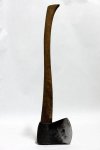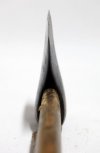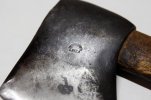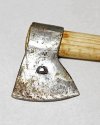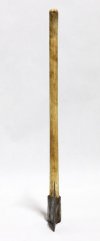- Joined
- Feb 27, 2013
- Messages
- 344
Thunderstick, tomahawks had all type of eyes, look at this page,
http://www.furtradetomahawks.com/the-iroquois-spike-tomahawks.html
The steel tomahawk was a evolution of the trade axe. Most of the first trade axes and the oldest trade axe recorded in North American history are Biscayne axes, carpenter type Basque axe. Look at these,
http://www.furtradetomahawks.com/biscayne-trade-axes.html
[video=youtube;4jpw-PbR3wg]https://www.youtube.com/watch?v=4jpw-PbR3wg[/video]
I have experience with these type of axes, I have tried to learn its history and I have rehafted normal and oval eye axes and cilindrical eyes on other type of tools. I think I know what I'm speaking about.
Thinking about you have written, I don't think you have ever used a conical cilindrical eye axe and your post telling "If the handle breaks in the woods, you could burn out the eye in a campfire" makes me think you don't have much practical experience in axe manteinance.
There is a simple way to see what type of axe is easier to rehaft. I apologize if I don't use correct terms, English is my third language and I don't dominate completely the technical side of it.
Today globally normal type eye,
1.-Take out the broken handle, it can take you a bit because it has not a prefered exit way.
2.-Take a piece of wood and give it the shape you need.
3.-Take a saw an cut the handle were you are going to insert the wedge. Note, you need a saw.
4.-Take a piece of wood and fabricate a wedge.
5.-Fit the handle in the head.
6.-Insert the wedge in its position.
Slip-fit type eye,
1.-Take out the broken handle. It will be easier than the wedge type of eye because it is conic. Hit from the bottom side of the eye till it gets out.
2.-Take a piece of wood and give it the shape you need.
3.-Fit the handle in the head.
As I have posted in other topic all axemakers could implement conic eyes in their axes and they could sell them with a normal handle. This way when a handle breaks you could rehandle it with any handle you want or can. I have sent emails to (in my opinion) the best axe manufacturers explaining my point of view and I haven't had any response. I don't know, my emails can be in the "crazy axe fan" bin or the need to buy them any new handle, or even an entire new axe, can be a purely commercial decision. I think the second one is the true, take Fiskars as a example.
Square_peg, I like your idea. Its a good method when you are in a hurry, but it will not stand the pounding a normal handle can suffer. I'll read and take part in your topic as soon as I can, this topic has consumed almost all my time.
http://www.furtradetomahawks.com/the-iroquois-spike-tomahawks.html
The steel tomahawk was a evolution of the trade axe. Most of the first trade axes and the oldest trade axe recorded in North American history are Biscayne axes, carpenter type Basque axe. Look at these,
http://www.furtradetomahawks.com/biscayne-trade-axes.html
[video=youtube;4jpw-PbR3wg]https://www.youtube.com/watch?v=4jpw-PbR3wg[/video]
I have experience with these type of axes, I have tried to learn its history and I have rehafted normal and oval eye axes and cilindrical eyes on other type of tools. I think I know what I'm speaking about.
Thinking about you have written, I don't think you have ever used a conical cilindrical eye axe and your post telling "If the handle breaks in the woods, you could burn out the eye in a campfire" makes me think you don't have much practical experience in axe manteinance.
There is a simple way to see what type of axe is easier to rehaft. I apologize if I don't use correct terms, English is my third language and I don't dominate completely the technical side of it.
Today globally normal type eye,
1.-Take out the broken handle, it can take you a bit because it has not a prefered exit way.
2.-Take a piece of wood and give it the shape you need.
3.-Take a saw an cut the handle were you are going to insert the wedge. Note, you need a saw.
4.-Take a piece of wood and fabricate a wedge.
5.-Fit the handle in the head.
6.-Insert the wedge in its position.
Slip-fit type eye,
1.-Take out the broken handle. It will be easier than the wedge type of eye because it is conic. Hit from the bottom side of the eye till it gets out.
2.-Take a piece of wood and give it the shape you need.
3.-Fit the handle in the head.
As I have posted in other topic all axemakers could implement conic eyes in their axes and they could sell them with a normal handle. This way when a handle breaks you could rehandle it with any handle you want or can. I have sent emails to (in my opinion) the best axe manufacturers explaining my point of view and I haven't had any response. I don't know, my emails can be in the "crazy axe fan" bin or the need to buy them any new handle, or even an entire new axe, can be a purely commercial decision. I think the second one is the true, take Fiskars as a example.
Square_peg, I like your idea. Its a good method when you are in a hurry, but it will not stand the pounding a normal handle can suffer. I'll read and take part in your topic as soon as I can, this topic has consumed almost all my time.
Last edited:


